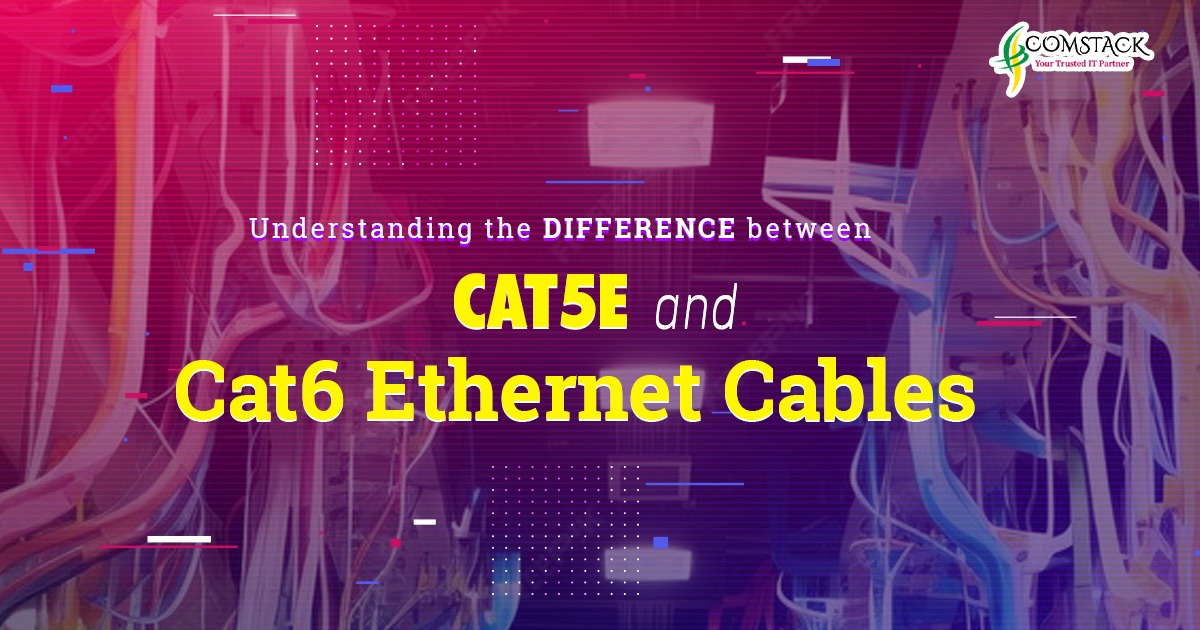In Canada’s evolving networking landscape, the selection of the appropriate Ethernet cable is pivotal for ensuring optimal network performance and reliability. Two prevalent standards in the realm of Ethernet cables are Category 5e (Cat5e) and Category 6 (Cat6). While they may appear similar on the surface, there exist several critical distinctions between the two. Let’s delve into these disparities in detail and find out if CAT5e cabling is better than CAT6 or vice-versa.
Cat5e Ethernet Cables
Cat5e cables represent an advancement over the original Cat5 standard. Designed to support Gigabit Ethernet, these cables are well-suited for residential and small to medium-sized business networks across Canada.
Performance
Capable of transmitting data at speeds of up to 1 Gigabit per second (Gbps) over a maximum distance of 100 meters, Cat5e cables operate within a frequency range of up to 100 MHz.
Construction
Typically comprising four twisted pairs of copper wires encased in a plastic sheath, Cat5e cables boast compatibility with most networking devices through RJ45 connectors.
Cost
Cat5e cables are generally more budget-friendly compared to their Cat6 counterparts, making them a preferred choice among cost-conscious consumers and businesses in Canada.
Common Applications
Cat5e cables find widespread use in basic networking applications such as connecting computers, printers, and various devices to a local area network (LAN) throughout Canada.
Cat6 Ethernet Cables
Cat6 cables are engineered to deliver superior performance and support higher data transfer speeds compared to Cat5e cabling. They are particularly well-suited for demanding networking environments in Canada that necessitate increased bandwidth and reduced interference.
Performance
With the capability to support data transfer speeds of up to 10 Gbps over a maximum distance of 55 meters, Cat6 cables operate within a frequency range of up to 250 MHz, facilitating greater bandwidth capacity.
Construction
Distinguished by thicker gauge copper wires and tighter twists than Cat5e cables, Cat6 cables are adept at mitigating crosstalk and electromagnetic interference, thereby enhancing signal integrity.
Cost
Although Cat6 cables typically command a higher price point than Cat5e cables due to their superior performance specifications and stringent manufacturing requirements, the cost discrepancy has gradually diminished over time with the increased adoption of Cat6 cabling in Canada.
Common Applications for Difference between Cat5e and Cat6 Ethernet Cables
Cat6 cables are extensively utilized in Canadian environments where high-speed data transmission is imperative, including data centers, large enterprises, and multimedia streaming applications. Moreover, they are instrumental in future-proofing network installations to accommodate emerging technologies that demand greater bandwidth.
What are the main differences between Cat5e cabling and Cat6 Cables?
Performance and Bandwidth
A prominent disparity between Cat5e and Cat6 cables lies in their performance capabilities. Cat6 cables offer substantially higher data transfer speeds (up to 10 Gbps) and greater bandwidth capacity (up to 250 MHz) compared to Cat5e cables, rendering them indispensable for high-performance networking applications in Canada.
Interference and Crosstalk
Cat6 cables adhere to stricter specifications for minimizing interference and crosstalk in comparison to Cat5e cables. This attribute renders Cat6 cables more adept at thriving in Canadian environments characterized by elevated levels of electromagnetic interference, such as those proximate to power lines or industrial equipment.
Cost
While Cat6 cables typically entail a higher upfront investment relative to Cat5e cables owing to their enhanced performance specifications and more rigorous manufacturing requirements, the diminishing cost discrepancy over time underscores the burgeoning affordability of Cat6 cabling solutions in Canada.
Compatibility
Cat6 cables boast backward compatibility with Cat5e and Cat5 standards, enabling their integration into setups necessitating Cat5e or Cat5 cables. Conversely, Cat5e cables lack the requisite performance to support the higher standards of Cat6, thereby limiting their suitability for future-proofing network installations in Canada.
Common Applications
While Cat5e cables suffice for fundamental networking applications within Canadian LANs, Cat6 cables emerge as the preferred choice for networking environments demanding heightened data transfer speeds and bandwidth capacity, such as those prevalent in data centers, large enterprises, and multimedia streaming applications.
Conclusion
While both Cat5e and Cat6 cables serve distinct purposes within Canadian network installations, the selection between the two hinges on factors including performance requirements, budget constraints, and future scalability needs. A comprehensive understanding of the disparities between these two standards empowers Canadian consumers and businesses to make well-informed decisions when procuring Ethernet cables for their network infrastructure.
Know more: https://en.wikipedia.org/wiki/Category_5_cable


